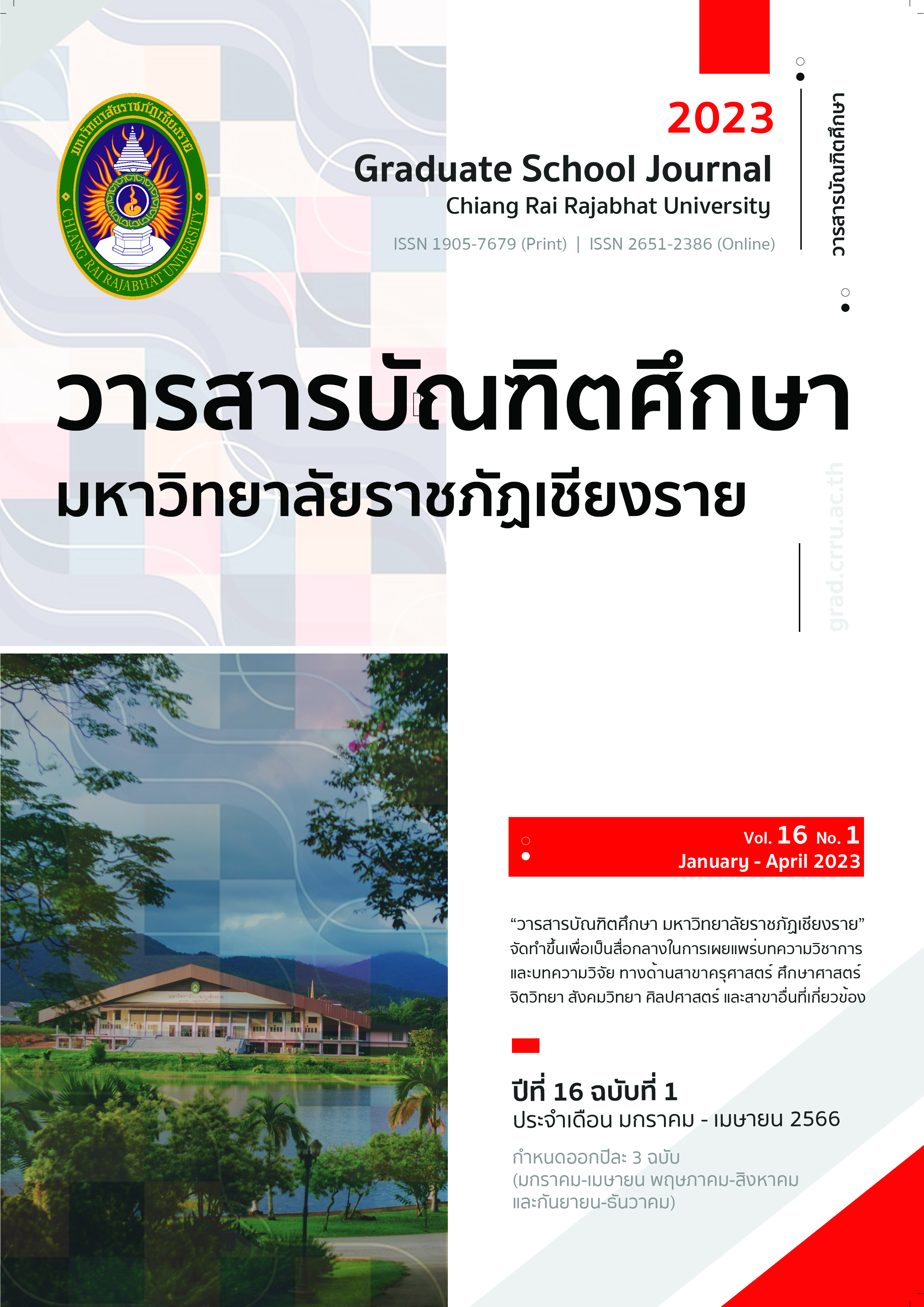การรับรู้ความปลอดภัยของนักท่องเที่ยวในการท่องเที่ยวพิพิธภัณฑ์ ในช่วงสถานการณ์การแพร่ระบาดโควิด-19
Main Article Content
บทคัดย่อ
บทความนี้นำเสนอประเด็นเกี่ยวกับการรับรู้ความปลอดภัยในพิพิธภัณฑ์ที่ส่งผลต่อความรู้สึกปลอดภัยของนักท่องเที่ยวในการท่องเที่ยวพิพิธภัณฑ์ช่วงสถานการณ์การแพร่ระบาดโควิด-19 โดยนำเอาทฤษฎีระบบความปลอดภัยมาอธิบายปรากฏการดังกล่าวว่า นักท่องเที่ยวในพิพิธภัณฑ์จะประเมินความปลอดภัยของพิพิธภัณฑ์จาก 4 องค์ประกอบ ได้แก่ องค์ประกอบด้านมนุษย์ องค์ประกอบด้านสิ่งอำนวยความสะดวกและเครื่องไม้เครื่องมือ ในพิพิธภัณฑ์ องค์ประกอบด้านสภาพแวดล้อมทั้งภายนอกและภายในพิพิธภัณฑ์ และองค์ประกอบด้านการจัดการ ของพิพิธภัณฑ์ โดยบทความวิชาการนี้ยังได้นำเสนอว่า การทำให้นักท่องเที่ยวพิพิธภัณฑ์รู้สึกว่าการเดินทางท่องเที่ยว ในพิพิธภัณฑ์นั้นปลอดภัยโดยเฉพาะในช่วงที่มีการแพร่ระบาดของโควิด-19 นอกจากจะส่งผลกระทบโดยตรงต่อความตั้งใจเชิงพฤติกรรมของนักท่องเที่ยวแล้ว ยังสามารถสร้างความไว้วางใจให้แก่นักท่องเที่ยว และสร้างภาพลักษณ์ ที่ดีให้แก่พิพิธภัณฑ์อันจะก่อให้เกิดการเดินทางกลับมาท่องเที่ยวซ้ำและแนะนำบอกต่อของนักท่องเที่ยวพิพิธภัณฑ์ได้ในที่สุดอีกด้วย ดังนั้น บทความวิชาการชิ้นนี้จะสามารถนำไปใช้เป็นแนวทางให้กับพิพิธภัณฑ์ในการส่งเสริมการท่องเที่ยวพิพิธภัณฑ์ให้มีความปลอดภัยในทุกด้านเพื่อสร้างความไว้วางใจและสร้างภาพลักษณ์ที่ดี และก่อให้เกิดการตัดสินใจเดินทางท่องเที่ยวของนักท่องเที่ยวต่อไป
Article Details

อนุญาตภายใต้เงื่อนไข Creative Commons Attribution-NonCommercial-NoDerivatives 4.0 International License.
บทความที่ได้รับการตีพิมพ์เป็นลิขสิทธิ์ของวารสารมหาวิทยาลัยราชภัฎเชียงราย
ข้อความที่ปรากฏในบทความแต่ละเรื่องในวารสารวิชาการเล่มนี้เป็นความคิดเห็นส่วนตัวของผู้เขียนแต่ละท่านไม่เกี่ยวข้องกับมหาวิทยาลัยราชภัฎเชียงราย และคณาจารย์ท่านอื่นๆในมหาวิทยาลัยฯ แต่อย่างใด ความรับผิดชอบองค์ประกอบทั้งหมดของบทความแต่ละเรื่องเป็นของผู้เขียนแต่ละท่าน หากมีความผิดพลาดใดๆ ผู้เขียนแต่ละท่านจะรับผิดชอบบทความของตนเองแต่ผู้เดียว
เอกสารอ้างอิง
กระทรวงการท่องเที่ยวและกีฬา. (2563). COVID-19 กับผลกระทบต่อการท่องเที่ยวไทย สถานการณ์การท่องเที่ยวของประเทศไทย ไตรมาส 1/2563. สืบค้นจากhttps://www.mots.go.th/download/TourismEconomicReport
กระทรวงสาธารณสุข. (2564). แนวปฏิบัติด้านสาธารณสุขเพื่อการป้องกันการแพร่ระบาดของเชื้อไวรัสโคโรนา 2019 (COVID-19) กรณีเปิดสถานประกอบกิจการในพื้นที่ควบคุมสูงสุดและเข้มงวด มาตรการปลอดภัย สำหรับพิพิธภัณฑ์ พิพิธภัณฑ์สถาน พิพิธภัณฑ์ท้องถิ่น รวมถึงพิพิธภัณฑ์ในลักษณะเดียวกัน สืบค้นจาก *20c870df4958349aa8c6e53fa6d76b54.pdf (moph.go.th)
ฐาปกรณ์ ทองคำนุช, เกษวดี พุทธภูมิพิทักษ์ และอรวรรณ ศิริสวัสดิ์ อภิชยกุล. (2564). การส่งเสริมการท่องเที่ยวเชิงพิพิธภัณฑ์ในประเทศไทยด้วยแนวคิดพิพิธภัณฑ์จุดหมายปลายทาง. วารสารบัณฑิตศึกษา มหาวิทยาลับราชภัฏไลยอลงกรณ์ ในพระบรมราชูปถัมภ์, 15(1), 38-52.
บริสุทธิ์ แสนคำ. (2564). พฤติกรรมการท่องเที่ยวของนักท่องเที่ยวชาวไทยหลังสถานการณ์โควิด19. วารสารศิลปศาสตร์และอุตสาหกรรมบริการ (Journal of Liberal Arts and Service Industry), 4(1), 160-167.
พงศ์ศิริ คำขันแก้ว, พัชราภรณ์ ลิมปิอังคนันต์, ธรรมนูญ พ่อค้าทอง และสุกฤษฎิ์ ลิ้ม โพธิ์ทอง. (2563). อิทธิพล ของภาพลักษณ์การท่องเที่ยวและการรับรู้ความปลอดภัยแหล่งท่องเที่ยวที่ส่งผลต่อความตั้งใจกลับมา เที่ยวซ้ำของนักท่องเที่ยวในจังหวัดเมืองรองกลุ่มภาคเหนือตอนบน. วารสารวิชาการการตลาดและการจัดการ มหาวิทยาลัยเทคโนโลยีราชมงคลธัญบุรี, 7(2), 64-78.
ยูเนสโก้ กรุงเทพ. (2563). การท่องเที่ยวเชิงวัฒนธรรมในสภาวะไร้นักท่องเที่ยว ถึงเวลาต้องเปลี่ยนแปลง?. สืบค้นจาก https://bangkok.unesco.org/content/th/cultural-tourism-without-tourists-beyond-business-usual
อัจจิมา หนูคง, ไพบูลย์ ดวงจันทร์, ฉันทัส ทองช่วย, & มัณฑนา นวลเจริญ. (2559). การจัดการพิพิธภัณฑ์อย่าง สร้างสรรค์เพื่อการท่องเที่ยวทางวัฒนธรรมในจังหวัดภูเก็ต (Creative museums management for cultural tourism in Phuket province). วารสารอินทนิลทักษิณสาร มหาวิทยาลัยทักษิณ, 10(2), 179-197.
Ajzen, I., & Fishbein, M. (1975). A Bayesian analysis of attribution processes. Psychological Bulletin, 82(2), 261–277.
Bentley, T., Page, S., Meyer, D., Chalmers, D., & Laird, I. (2001). How safe is adventure tourism in New Zealand? An exploratory analysis. Applied Ergonomics, 32(4), 327-338.
Caber, M., & Albayrak, T. (2018). Assessing daily tour service quality: A proposal for a DAILYSERV scale. Journal of Destination Marketing & Management, 7, 18-25.
Cao, J., Lin, L., Zhang, J., Zhang, L., Wang, Y., & Wang, J. (2021). The development and validation of the perceived safety of intelligent connected vehicles scale. Accident Analysis & Prevention, 154(2021), 1-10.
Crompton, J. L. (1979). Motivations for pleasure vacation. Annals of Tourism Research, 6(4), 408-424.
Edwards, E. (1972). Proceedings of British Airline Pilots Association Technical Symposium. London: British Airline Pilots Association.
Hübner, A., & Gössling, S. (2012). Tourist perceptions of extreme weather events in Martinique. Journal of Destination Marketing & Management, 1(1-2), 47-55.
International Council on Monuments and Sites. (2022) Museum definition. Retrieved from https://icom.museum/en/resources/standards-guidelines/museum-definition/
Kim, Y. R., & Liu, A. (2022). Social distancing, trust and post-COVID-19 recovery. Tourism Management, 88, 1-11.
Lai, I. K. W., Hitchcock, M., Lu, D., & Liu, Y. (2018). The influence of word of mouth on tourism destination choice: Tourist–resident relationship and safety perception among Mainland Chinese tourists visiting Macau. Sustainability, 10(7), 1-17.
Lee, Y., Pennington-Gray, L., & Kim, J. (2019). Does location matter? Exploring the spatial patterns of food safety in a tourism destination. Tourism Management, 71, 18-33.
Liu, J., Wang, C., Fang, S., & Zhang, T. (2019). Scale development for tourist trust toward a tourism destination. Tourism Management Perspectives, 31, 383-397.
Lu, L. (2019). Online information search, familiarity, hotel expectation, perceived safety, and destination image of Thailand: A comparison between Asian and Western tourists. Journal of Hospitality, 1(1), 50-62.
Montoro, L., Useche, S. A., Alonso, F., Lijarcio, I., Bosó-Seguí, P., & Martí-Belda, A. (2019). Perceived safety and attributed value as predictors of the intention to use autonomous vehicles: A national study with Spanish drivers. Safety Science, 120, 865-876.
Najda-Janoszka, M., & Sawczuk, M. (2018). Proceedings of the 17th conference of scientists and business people. Poland: Wydawnictwo I Drukarnia Nova Sandec.
Nazir, M. U., Yasin, I., & Tat, H. H. (2021). Destination image's mediating role between perceived risks, perceived constraints, and behavioral intention. Heliyon, 7(7), 1-11.
Rittichainuwat, N. (2013). Responding to disaster: Thai and Scandinavian tourists' motivation to visit Phuket, Thailand. Journal of Travel Research, 46(4), 422-432.
Shin, H., Nicolau, J. L., Kang, J., Sharma, A., & Lee, H. (2022). Travel decision determinants during and after COVID-19: The role of tourist trust, travel constraints, and attitudinal factors. Tourism Management, 88, 1-14.
Su, L., Lian, Q., & Huang, Y. (2020). How do tourists' attribution of destination social responsibility motives impact trust and intention to visit? The moderating role of destination reputation. Tourism Management, 77, 1-13.
Tsaur, S. H., Cheng, T. M., & Hong, C. Y. (2019). Exploring tour member misbehavior in group package tours. Tourism Management, 71, 34-43.
Xie, C., Zhang, J., & Morrison, A. M. (2021). Developing a scale to measure tourist perceived safety. Journal of Travel Research, 60(6), 1232-1251.
Xu, F., Lin, X., Li, S., & Niu, W. (2018). Is Southern Xinjiang really unsafe?. Sustainability, 10(12), 1-21.


